While credit union charters may have changed, marketing mindsets may have not, according to Portrie. "I think when we deregulated, we missed that loop to truly undersatnd and see how (customers) work with the banking industry," he said. Unlike when Portrie joined Northern Massachusetts Telephone Workers CU, your neighbors may not know how a credit union "works," despite the myriad ways you have of touching them everyday. Exacerbating the problem is that more competitors are trying to reach more customers who have more alternatives. Insurance companies sell "financial solutions." Pitney Bowes issues credit cards. Has Wal- Mart given up efforts to start up a bank? "What we're seeing is a collapse of competition," Portrie said. "So many people (competitors) are touching the same thing. What we want to know is how does that affect the consumer?"
Despite all the changes, marketing strategies remain largely the same. TV, radio and print advertising account for 80 percent of all marketing dollars spent, according to Portrie. Meanwhile, consumers report using new media 45 percent of the time (in relation to TV, radio and print). Dollars spent on new media advertising are a disproportionate 17 percent of marketing budgets. "We know that what the customer wants is much different than what the old marketing campaign was," Portrie said. Innovative marketers are moving from a product-based approach to one that is customer-centric. In this model, market share is replaced by share of wallet. Instead of being campaign driven, these programs arerelationship driven. They are based on sustainable and on going dialog with members rather than productfocused dialog.
The most compelling example Portrie described came from, of all places, the packaged food industry. As vice president at Kraft Foods, Irene Rosenfeld concentrated on moving Kraft's marketing from a campaign framework to a lifecycle framework. Kraft rolled out Food and Family magazine, a glossy, wellpresented magazine, after a mass mailing steered customers to Kraft's revamped Web site where they could opt to subscribe to the magazine. Basically, Kraft created a need for its customers that they didn't know they had. (Read more about this concept in "See It, and Make It Happen," another article from CUES Annual Convention.) In addition, Kraft has turned its customer relationship management system into one of the most sophisticated programs in the world, based on the touch points offered by Food and Family magazine and kraftfoods.com. The company has 350 million direct consumer touches per year. Even better, the company's response rate is 50 percent to 300 percent higher than industry averages. Portrie said Kraft Foods spends $3 per customer in "acquiring" those member contacts. In return, it achieves $73 in revenue. As for Irene Rosenfeld? She is now president/CEO of the company. Credit unions have established at least a solid base of contact points, both on the street and on the Web. "The membership of the credit union is the gold of your life," Portrie said. "If you understand their needs, and segment their needs, and truly serve those needs ... you can grow your credit union."

